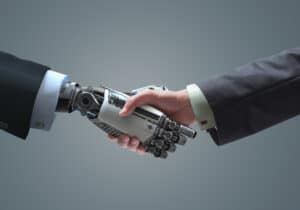
As global industry continues to find a place for automation in ever-evolving ways, the way humans involve themselves in production and service will continue to evolve, as well.
With rapidly evolving technology seeping into everything we do — from grocery shopping to scheduling appointments with our doctors — we have become accustomed to automation. Retailers and e-commerce platforms such as Amazon rely more on automation, resulting in increased costs, fees, and headaches for e-commerce retailers. We see this every day, and it’s scary.
Nevertheless, the takeover of automated services has led to a longing for the days of human connection in business and commerce, especially when there are errors to be mitigated or questions to be answered. Full automation is not always the best route for business transactions, and there is value to be found in keeping some human-to-human connection in e-commerce and B2B/B2C interactions.
See also: Why Humanizing Automation Is Critical to Its Success
The rise of automation
When Americans think of the surge of automation in business, it may seem like it is taking over everything. Automation of the auto industry has primarily frozen out a large portion of the human workforce, and the same can be said for nearly all of eCommerce regarding the retail industry.
How many of us have spent time on the phone or over an autobot chat line begging to speak with an actual human being? How many of us have bemoaned having self-check as our only option at the big box store? While the rise of automation has helped society in many ways — saving customers time and corporations money, for instance — it has left an indelible mark on social interaction expectations, error mitigation, and job production.
Other countries, such as Japan and China, have fully embraced automation, making them highly competitive in the global economy. The United States has traditionally fallen behind in the race to automate, especially with pushback from workers who took umbrage with being replaced by robots or computer programs. The desire to remain globally competitive has allowed automation to be increasingly accepted, albeit somewhat begrudgingly.
Even given our qualms with the rise of automation, many of us take advantage of the benefits of automation regularly. Robots almost completely control Amazon’s warehouses and the lightning-fast path between order and delivery. The only problem is that it is still far from perfect. Vendors and sellers literally lose money daily because of it, and most don’t even realize the extent of the problem. After all, most of us likely don’t give a second thought to how incredible it is to order something online and have it on our doorstep within 24 hours of clicking the “buy” button. We expect Amazon and other e-commerce platforms like it to have this all figured out for us already.
See also: Real-Time and Automation: Trends to Watch in 2023
The human factor in error mitigation
Even given the benefits of automation, especially in e-commerce, errors and questions are bound to arise. After all, there is still human involvement in placing orders, selling products, and physically delivering items. Frustrations can quickly occur when an order is incorrect or if a vendor is facing an issue with their online store. An overreliance on automation can get in the way of mitigation in the case of errors or questions.
Some will sing the praises of automation regarding customer service and error correction. Proponents of this type of automation will say that it saves time in the long run, providing answers and solutions quickly. Automated customer support also allows people to receive help 24/7, eliminating the issue of having to wait until standard business hours to get an issue resolved. Automatic billing, chatbots, and AI-assisted customer service have increasingly become the standard, particularly for e-commerce vendors.
When a business owner has an issue — especially if it involves money, fees, or overcharges — dealing with an endless series of automated responses can get frustrating. If those automated responses do not lead them to the help they ultimately need, that frustration can (and likely will) compound further. Even the most intuitive automated solutions can’t replace a human’s personality, emotional response, and instinctual capabilities to adapt to any situation. A chatbot cannot fully de-escalate an emotionally-charged situation, especially if the situation concerns a customer’s or vendor’s hard-earned money (which it almost always does). The trust that people hold in a brand or platform may be eroded if they are forced into a cycle of unhelpful and seemingly endless amounts of automated solutions to issues.
With vendors working with large platforms such as Amazon, there can be friction built-in to the relationship because the vendor is at the mercy of the platform to sell their wares. They have to follow the platform’s guidelines and accept their fees as a part of doing business. When the level of support loses the human element, platforms can risk alienating their vendors. Expert knowledge in these platforms is no longer a nice-to-have but a needed necessity.
See also: Even Partial Automation Can Accelerate a Digital Transformation Journey
Job production
Studies show that up to 375 million jobs could be lost to automation globally by 2030. Many of those jobs may be repetitive positions where automation could improve speed and efficiency, though the rise of automation in customer service positions is leaving many professionals out in the cold.
Consumers and entrepreneurs alike are craving human connection in today’s increasingly automated world, so much so that many brands are making the personal relationships they foster with customers an angle of their sales strategy. Companies that are still relying on people to serve their customers, or to solve issues and answer questions, are making that distinction part of their marketing plans, knowing full well that it may endear them to their target market.
The societal cost of automation may become more evident as the years progress, and technology becomes an increasing part of our day-to-day lives, including worries about decreased job growth. However, automation in and of itself still involves human involvement, however different that involvement may be from the past. The World Economic Forum has found through research that there will be a net increase of 13 million jobs globally by 2025 created through automation. Positions in IT and design roles, user experience (UX), and higher-level customer support will still be in demand.
Automation has changed our lives. It’s made connecting to large companies easier, made help more available, and has made many tasks faster and more efficient across numerous industries. Yet, there is still immense value to be found in human involvement within these industries. No matter how much the reliance on automation grows, there will always be a place for human involvement in business, commerce, and service. A McKinsey study conducted in 2020 showed that companies that wove humans “in the loop” with automated initiatives were ultimately more successful at scaling. Studies such as this give hope to customers and businesses that have been frustrated by the lack of personal connection from automated services.
As global industry continues to find a place for automation in ever-evolving ways, the way humans involve themselves in production and service will continue to evolve, as well. This evolution may involve humans learning new technical skills or businesses placing a renewed higher value on customer connection. As this growth occurs, the end goal will continue to be a balance between automation and human involvement that will best serve businesses, eCommerce platforms, and customers.






























